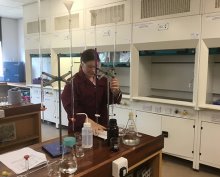
By Emily Pinkney (Lower Sixth)
As part of our IB Chemistry course, we have to submit an IA (Internal Assessment) which takes the form of a research project. The Chemistry IA offers us an opportunity to delve deeper into a Chemistry-related topic that captivates our interest. There is an element of personal engagement and we are able to formulate our own research question. The analysis can be from first-hand experimental data or a meta-analysis of data already published, although most students choose to carry out their own practical work. We then produce a final report which is worth 20% of our final grade.
After discussing our ideas, researching background information and planning our methods, we spent the whole of Thursday 15th June carrying out our practical experiments.
My experiment involved looking at the effect of changing the concentration of oxalate ions on the rate of reaction between manganate (VII) ions and oxalate ions. I became interested in this experiment after researching how diets high in oxalate foods have been linked to an increased risk of kidney stones in sensitive individuals as they bind to calcium to form calcium oxalate. This led me to think about how different concentrations of oxalate could impact rates of reactions, and so I decided to use a common oxidising agent, potassium manganate (VII), to explore this in a laboratory environment. I also particularly enjoyed using the colourimeter so I thought it would be the perfect opportunity to combine both of these interests together.
The first hour of Thursday morning was a bit daunting as I was not 100% sure how my experiment would work out, but after completing three trials of the first concentration of oxalic acid, it began to feel a lot easier. Over the course of the day, I would say that my accuracy and practical skills developed massively and I definitely felt a sense of achievement at the end despite being tired from a long day in the lab!
Haneha Kaur (Lower Sixth), who investigated the effect of concentration of pancreatic enzymes on the rate of hydrolysis of triacylglycerol, said, ‘It widened my experiences of working in a lab and allowed me to explore my interests within a controlled environment. I thoroughly enjoyed the day.”





















